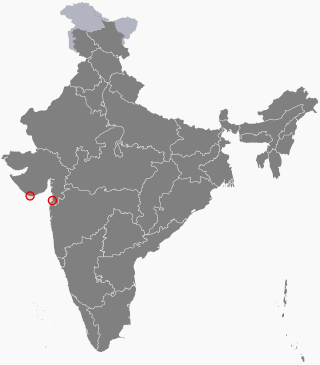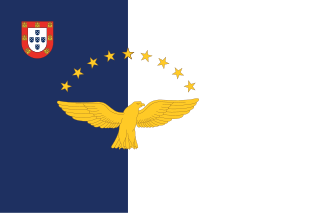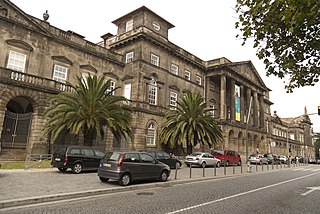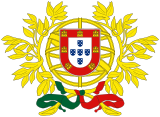
Local government is a generic term for the lowest tiers of governance or public administration within a particular sovereign state.

The municipality is the second-level administrative subdivision of Portugal, as defined by the 1976 Constitution.

Portugal is a unitary state with delegated authority to three levels of local government that cover the entire country:

Daman and Diu was a union territory in northwestern India. With an area of 112 km2 (43 sq mi), it was the smallest administrative subdivision of India on the mainland. The territory comprised two districts, Daman and Diu island, geographically separated by the Gulf of Khambat. The state of Gujarat and the Arabian Sea bordered the territory. A Portuguese colony since the 1500s, the territories were taken by India with the Annexation of Goa in 1961. Daman and Diu were administered as part of the union territory of Goa, Daman and Diu between 1961 and 1987. After the Goa Opinion Poll, they became a separate union territory. In 2019, legislation was passed to merge the union territory of Daman and Diu with its neighbouring union territory, Dadra and Nagar Haveli, to form the new union territory of Dadra and Nagar Haveli and Daman and Diu with effect from 26 January 2020.

Freguesia, usually translated as "parish" or "civil parish", is the third-level administrative subdivision of Portugal, as defined by the 1976 Constitution. It is also the designation for local government jurisdictions in the former Portuguese overseas territories of Cape Verde and Macau. In the past, it was also an administrative division of the other Portuguese overseas territories. The parroquia in the Spanish autonomous communities of Galicia and Asturias is similar to a freguesia. The average land area of a Portuguese parish is about 29.83 km2 (11.52 sq mi) and an average population of about 3,386 people. The largest parish by area is Alcácer do Sal e Santa Susana, with a land area of 888.35 km2 (342.99 sq mi), and the smallest parish by area is São Bartolomeu (Borba), with a land area of 0.208 km2 (0.080 sq mi). The most populous parish is Algueirão - Mem Martins, with a population of 68,649 people and the least populous is Mosteiro, with a population of just nineteen people.

The Lisbon Metropolitan Area is a metropolitan area in Portugal centered on Lisbon, the capital and largest city of the country. The metropolitan area, covering 17 cities in 18 municipalities, is the largest urban area in the country and the 10th largest in the European Union, with a population in 2023 of 2,961,177 in an area of 3,015.24 km².
Each "article" in this category is a collection of entries about several stamp issuers, presented in alphabetical order. The entries are formulated on the micro model and so provide summary information about all known issuers.

Continental Portugal or mainland Portugal comprises the bulk of the Portuguese Republic, namely that part on the Iberian Peninsula and so in Continental Europe, having approximately 95% of the total population and 96.6% of the country's land. Mainland Portugal is therefore commonly called by residents of the Portuguese archipelagos of the Azores and Madeira the continent in all respects including minor elements of combined governance from Lisbon, the country's capital. Before 1975, when the Portuguese territory also stretched to several now-independent states in Africa, the designation metropolis was also used.

Goa, Daman and Diu was a union territory of the Republic of India established in 1961 following the annexation of Portuguese India, with Maj Gen K P Candeth as its first Military Governor. The Goa portion of the territory was granted full statehood within the Indian union on 30 May 1987, Daman and Diu remained a separate territory until December 2019, when it was merged with Dadra and Nagar Haveli and is today the territory of Dadra and Nagar Haveli and Daman and Diu.

The two Autonomous Regions of Portugal from 1999 are the Azores and Madeira. Together with Continental Portugal, they form the Portuguese Republic.
Daman district, is one of four districts of the Indian union territory of Dadra and Nagar Haveli and Daman and Diu. It is located on the west coast of India and is surrounded by the Valsad district of the Gujarat state to the north, east and south, and by the Arabian Sea to the west. The district covers an area of 72 square kilometers and had a population of 191,173 as of the 2011 census, an increase of 69.256% from the 2001 census. The district headquarters is Daman. Previously, the territorial headquarters were in Panjim when it was jointly administered as Goa, Daman, and Diu until the time of the Konkani language agitation.

Diu district is one of the three districts of the union territory of Dadra and Nagar Haveli and Daman and Diu of India. The district is made up of Diu Island and two small enclaves of Simbor and Gogola, at the border with the state of Gujarat. The district headquarters are at Diu Town. It is the ninth least populous district in the country.

The District of Ponta Delgada was a district of the Ilhas Adjacentes, consisting of the dependent eastern islands of the Azores, located in the Atlantic Ocean. The district of Ponta Delgada, not to be confused with the modern municipality of Ponta Delgada, existed from 1835 until 1976 when it was abolished in the favour of the autonomy charter of the 1975 Portuguese Constitution.

The Annexation of Goa was the process in which the Republic of India annexed the Portuguese State of India, the then Portuguese Indian territories of Goa, Daman and Diu, starting with the armed action carried out by the Indian Armed Forces in December 1961. In India, this action is referred to as the "Liberation of Goa". In Portugal, it is referred to as the "Invasion of Goa". Jawaharlal Nehru had hoped that the popular movement in Goa and the pressure of world public opinion would force the Portuguese Goan authorities to grant it independence, but without success; consequently, Krishna Menon suggested taking Goa by force.

The Roman Catholic Metropolitan Archdiocese of Goa and Daman encompasses the Goa state and the Damaon territory in the Konkan region, by the west coast of India. The ecclesiastical province of Goa and Damaon includes a suffragan diocese, the Sindhudurg Diocese that comprises the Malvani areas of. The Archbishop of Goa also holds the titles of Primate of the East and Patriarch of the East Indies, also hold the title of the Syrian Catholic Primate of the Archdiocese of Cranganore. The beginnings lie in the Padroado system of Portuguese Goa and Damaon, in the early 1900s the primatial see was transferred back to the Sacred Congregation for the Evangelisation of Peoples, as the Padroado system of the Indo-Portuguese era was being dismantled.

The political status of the Azores is defined by the Political-Administrative Statute of the Autonomous Region of the Azores, which acts as the standard legal constitutional framework for the autonomy of the Portuguese archipelago of the Azores. It defines the scope of the autonomous regional government and the structure and functioning of the region's organs of government within the framework of the 1976 Constitution of Portugal. The autonomous region of Madeira has a similar status.

Healthcare in Portugal is provided through three coexisting systems: the National Health Service, special social health insurance schemes for certain professions and voluntary private health insurance. The SNS provides universal coverage, although in 2012 measures were implemented to ensure the sustainability of the service by the introduction of user fees to be paid for at the end of treatments. In addition, about 25% of the population is covered by the health subsystems, 10% by private insurance schemes and another 7% by mutual funds. The Ministry of Health is responsible for developing health policy as well as managing the SNS. The Health Regulatory Entity (ERS) is the public independent entity responsible for the regulation of the activity of all the public, private and social healthcare providers. In 2019 the government proposes to scrap all fees, which constitute about 2 percent of the NHS's budget, apart from some hospital emergencies.

The Nomenclature of Territorial Units for Statistics (NUTS) is developed by Eurostat, and employed in both Portugal and the entire European Union for statistical purposes. The NUTS branch extends from NUTS1, NUTS2 and NUTS3 regions, with the complementary LAU sub-categorization being used to differentiate the local areas, of trans-national importance.

The term "provinces" has been used throughout history to identify regions of continental Portugal. Current legal subdivisions of Portugal do not coincide with the provinces, but several provinces, in their 19th- and 20th-century versions, still correspond to culturally relevant, strongly self-identifying categories. They include:
The present Portuguese order of precedence is defined by the Law of the Precedences of Protocol of the Portuguese State of 25th August 2006. This defines the following precedence:
- The President of the Republic
- The President of the Assembly of the Republic
- The Prime Minister
- The President of the Supreme Court and the President of the Constitutional Court
- The President of the Supreme Administrative Court and the President of the Court of Auditors
- Former Presidents of the Republic
- Ministers of the Government of Portugal
- The Leader of the Opposition
- Vice-presidents of the Assembly of the Republic and Presidents of the parliamentary groups
- The Attorney-general of the Republic
- The Chief of the General Staff of the Armed Forces
- The Ombudsman
- Representatives of the Republic to the Autonomous Regions
- Presidents of the Legislative Assemblies of the Autonomous Regions
- Presidents of the Regional Governments
- Leaders of other parties with seats in the Assembly of the Republic
- Former Presidents of the Assembly of the Republic and former Prime Ministers
- Councilors of State
- Presidents of Permanent Commissions of the Assembly of the Republic
- Secretaries and under-secretaries of State of the Government of Portugal
- Chiefs of Staff of the Army, Navy, and Air Force
- Members of the Assembly of the Republic
- Members of the European Parliament
- Marshals and Admirals of the fleet
- Chiefs of the Civilian House and Military House of the President of the Republic
- Presidents of the Economic and Social Council, of the National Association of Portuguese Municipalities and of the National Association of Freguesias
- The Governor of the Bank of Portugal
- Chancellors of Honorific Orders of Portugal
- Vice-presidents of the Supreme Judges Council
- Judges of the Constitutional Court
- Judges of the Supreme Court, Supreme Administrative Court, and Court of Audits
- Regional secretaries and under-secretaries of the Governments of the Autonomous Regions
- Members of the Legislative Assemblies of Autonomous Regions
- The Commandant-general of the National Republican Guard and the National Director of the Public Security Police
- Secretaries-general of the Presidency of the Republic, of the Assembly of the Republic, of the Presidency of the Council of Ministers and of the Ministry of Foreign Affairs
- The Chief of Protocol
- Presidents of intermediate level courts (Relação), Presidents of the Council of Rectors of Portuguese Universities and of the Coordinator Council of the Polytechnics, leaders of the Bar Associations and Presidents of professional associations of public law
- Presidents of the Portuguese Academy of History and the Lisbon Academy of Sciences, Rectors of universities and Presidents of Polytechnics
- Members of the councils of the Honorific Orders of Portugal
- Judges of intermediate level courts and deputies attorneys-general, vice-rectors of universities and vice-presidents of polytechnics
- Presidents of the municipal councils (Mayors)
- Presidents of the municipal assemblies
- Civil governors of districts
- Chiefs of Staff of the President of the Republic, President of the Assembly of the Republic, and Prime Minister
- Presidents, members and secretaries-general of councils, national councils, superior councils, oversight councils, national commissions, high authorities, high commissioners, oversight committees, by order of seniority of the respective institution, directors-general and presidents of public institutions, by order of their respective ministries, the head of the Santa Casa de Misericórdia, and the President of the Portuguese Red Cross
- Admirals and general officers with command functions, by order of military rank, operational commanders and commanders of military zone, maritime zone, and air zone, of the Autonomous Regions of Azores and Madeira
- Directors of the National Defense Institute and the Joint Command and Staff College, commanders of the Military Academy, Naval School, and Air Force Academy, admirals and general officers of 3 and 2 stars
- Chiefs of staff of members of government
- Deputies directors-general and regional directors
- Judges and attorneys-general
- Aldermans (vereadores) of municipal councils
- Aides of the President of the Republic, of the President of the Assembly of the Republic, and of the Prime Minister
- Presidents of Civil Parishes
- Members of municipal assemblies
- Presidents of parish assemblies and members of civil parishes and parish assemblies
- Directors of service
- Chiefs of division
- Aides of members of government
















